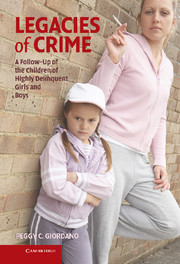Book contents
- Frontmatter
- Contents
- Acknowledgments
- 1 Introduction
- 2 Literature Review and Conceptual Framework
- 3 The Ohio Life-Course Study
- 4 OLS Adult Respondents: Offending, Surviving, Parenting
- 5 How Have the OLS Children Fared?
- 6 The Intergenerational Transmission Process
- 7 “Success Stories”: It's All Relative
- 8 Theoretical and Policy Implications of the OLS Study
- References
- Index
7 - “Success Stories”: It's All Relative
Published online by Cambridge University Press: 05 June 2012
- Frontmatter
- Contents
- Acknowledgments
- 1 Introduction
- 2 Literature Review and Conceptual Framework
- 3 The Ohio Life-Course Study
- 4 OLS Adult Respondents: Offending, Surviving, Parenting
- 5 How Have the OLS Children Fared?
- 6 The Intergenerational Transmission Process
- 7 “Success Stories”: It's All Relative
- 8 Theoretical and Policy Implications of the OLS Study
- References
- Index
Summary
I'm going to do this. Like, my dad literally fell off his chair when I told him. When I stood in front of him like this and said “Dad I'm going to school to be a nurse,” he fell. I mean, he never even expected me to graduate high school, because he expected me to be just like my mom.
[Kaley]In this book, we have focused primarily on continuities in behavior problems and family dynamics that are linked to the difficulties experienced by the next generation. Yet numerous studies of children exposed to risky environments – from poverty to natural disasters – have documented that, like Kaley, some children are “managing to make it” in spite of this exposure (Furstenberg et al., 1999). Children who beat the odds have been labeled “invulnerable” or “resilient” (Anthony & Cohler, 1987; Haggerty et al., 1996; Luthar, 2003). We prefer the word “resilient” since the concept of invulnerability implies that the child has not been affected by or is impervious to the difficulties they have faced in those milieus. On the other hand, resilience connotes adaptability and an ability to “bounce back” that seems more consistent with the life-course approach and the dynamics we have explored in this investigation (Rutter, 1987).
Prior research in the area of youth resilience has highlighted the remarkable finding that a large number of youth, despite the presence of significant stressors, do appear to avoid serious difficulties and even to thrive.
- Type
- Chapter
- Information
- Legacies of CrimeA Follow-Up of the Children of Highly Delinquent Girls and Boys, pp. 163 - 204Publisher: Cambridge University PressPrint publication year: 2010



